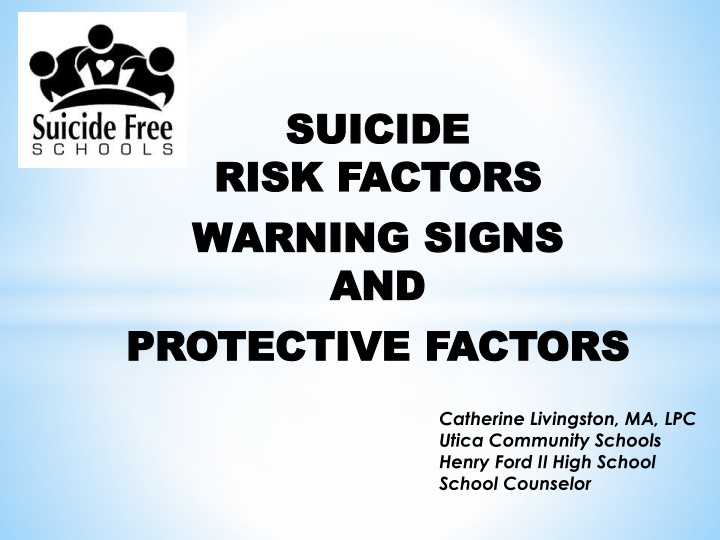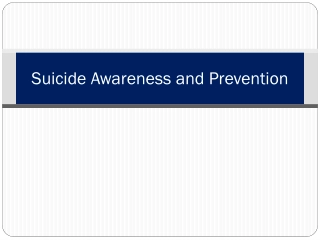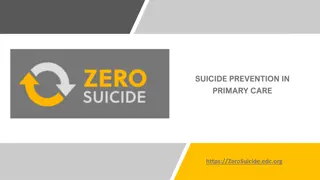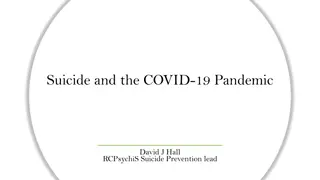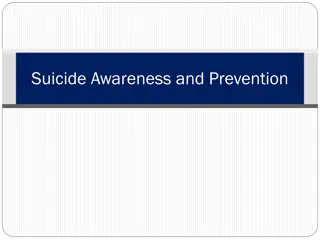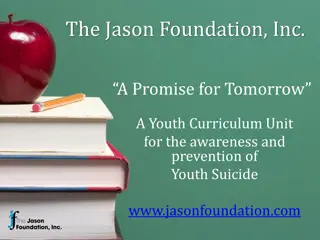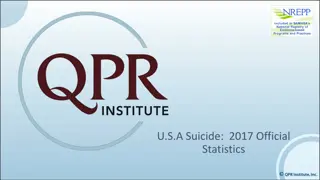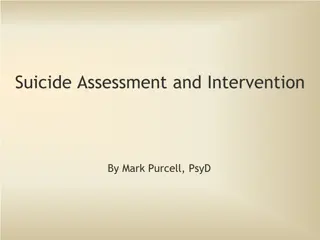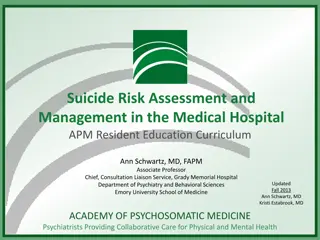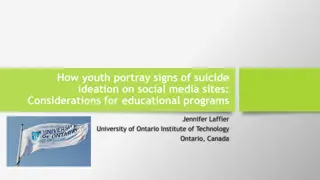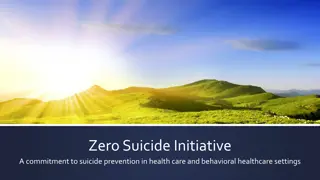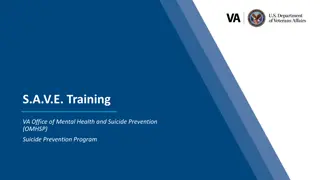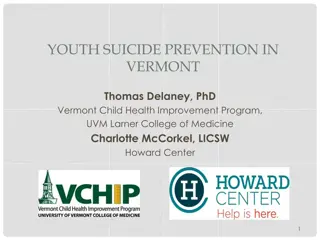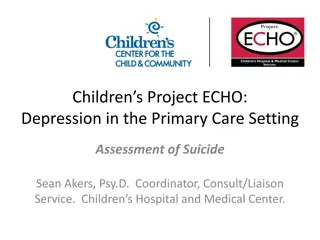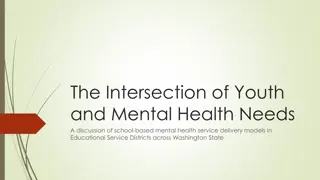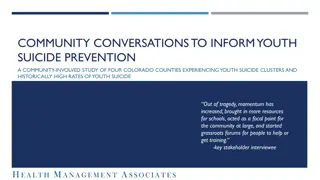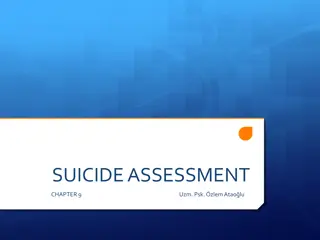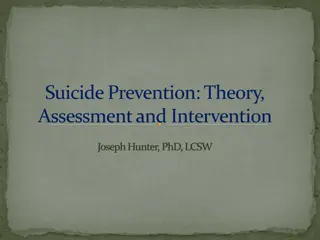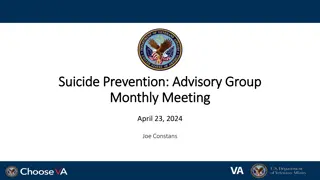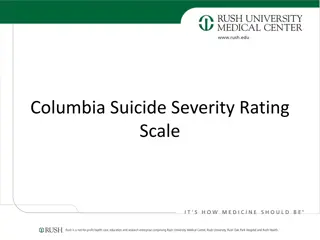Youth Suicide Risk Factors and Protective Measures
Adolescents are at risk of suicide due to various factors that can be identified through clues. Educators play a crucial role in recognizing warning signs, enhancing protective factors, and preventing tragedies. Training programs in schools focus on equipping faculty with the knowledge and tools needed to address youth suicide effectively. By being proactive and informed, educators can create a safe environment for students, reducing the likelihood of suicidal behaviors.
Download Presentation

Please find below an Image/Link to download the presentation.
The content on the website is provided AS IS for your information and personal use only. It may not be sold, licensed, or shared on other websites without obtaining consent from the author.If you encounter any issues during the download, it is possible that the publisher has removed the file from their server.
You are allowed to download the files provided on this website for personal or commercial use, subject to the condition that they are used lawfully. All files are the property of their respective owners.
The content on the website is provided AS IS for your information and personal use only. It may not be sold, licensed, or shared on other websites without obtaining consent from the author.
E N D
Presentation Transcript
SUICIDE SUICIDE RISK FACTORS RISK FACTORS WARNING WARNING SIGNS AND AND PROTECTIVE FACTORS PROTECTIVE FACTORS SIGNS Catherine Livingston, MA, LPC Utica Community Schools Henry Ford II High School School Counselor
WHY IS IT ESSENTIAL THAT EDUCATORS ARE TRAINED ABOUT YOUTH SUICIDE? Given the amount of time adolescents spend in school, it is imperative that school faculty and staff are educated about risk factors warning signs protective factors of suicidal behaviors.
THINK ABOUT IT 8760 hours in a year 2,920 an average school aged student spends sleeping (8 hours x 365 days) 5840 hours awake during the year 1225 hours spent in school equals to 20.9% of their awake time is spent in school
State Mandated Yearly Training (5 states) State Mandated Training, Not Yearly (16 states) State Encourages Training (16 states)..MICHIGAN Other School Suicide Prevention Statutes (13 states) House Bill 5154 (2015) instruction and professional development in warning signs for suicide and depression make mandatory
While adolescent suicide is not taken lightly risk factors warning signs and protective factors are often overlooked and mistaken.
Recognize The Clues
RISK FACTORS characteristics that make it more likely that someone will consider, attempt or die by suicide they can be considered"clues" long term risk (i.e. a year to a life time)
Previous Attempts Physical Abuse Sexual Abuse Conduct Disorder Disruptive Disorder Mental Health Disorder Substance Abuse Chronic Physical Sickness Exposure to Suicidal Behaviors
RISK FACTORS THAT CAN BE DETECTED IN SCHOOL Legal or Disciplinary Problems Juvenile Delinquency School Problem Aggressive-Impulsive Behaviors Being Homeless Running Away From Home
WARNING SIGNS behaviors and characteristics that someone may harm himself or herself in the near future These signs are considered "red flags
VERBAL WARNING SIGNS Talking about or making plans for suicide Making statements about hopelessness, helplessness, worthlessness, or being "beyond help Giving verbal statements such as "I won't be a problem for you much longer," "Nothing matters," "It's no use," and "I won't see you again. Complaints about being a bad person or feeling "rotten inside"
BEHAVIORAL WARNING SIGNS Difficulty concentrating or decline in quality of school work Withdraw from friends and family Loss of interest in things once cared about Loss of interest in pleasurable activities Preoccupation with death Giving away favorite possessions
MORE BEHAVIORAL WARNING SIGNS Exhibiting impulsivity such as violent behaviors/rebellious behaviors Marked personality changes or serious mood changes Change in eating habits and/or sleeping habits Becoming suddenly cheerful after a period of depression-this may mean that the student has already made the decision to escape all problems by ending his/her life
PROTECTIVE FACTORS factors that make it less likely that a someone will consider, attempt or die by suicide factors that enhance the student to develop strong coping skills
PROTECTIVE FACTORS Stable living environment Access to effective care for mental/physical/substance disorder Responsibilities for others/pets Religious or cultural belief Family cohesion Reduced access to means for suicidal behavior Help-seeking behavior/advice seeking behavior Impulse control
PROTECTIVE FACTORS IN SCHOOL Perceived connectedness to the school Support from teachers & other relevant adults Positive relationships with other students/peers Social integration/opportunities to participate Sports, clubs and other activities Problem solving/conflict resolution abilities Good coping skills Sense of worth/confidence
How To Respond
HOW TO RESPOND TO A STUDENT AT RISK 1. Ask if they are ok or if they are having thoughts of suicide 2. Express your concern about what you are observing in their behavior 3. Listen attentively and non-judgmentally 4. Reflect on what they share and let them know they have been heard 5. Inform them they are not alone and there are people that can help them 6. Guide them to professional help
A A A Ask sk the S question the S question S S S Seek eek better coping skills better coping skills K K K Know now how to make a how to make a safety plan safety plan
